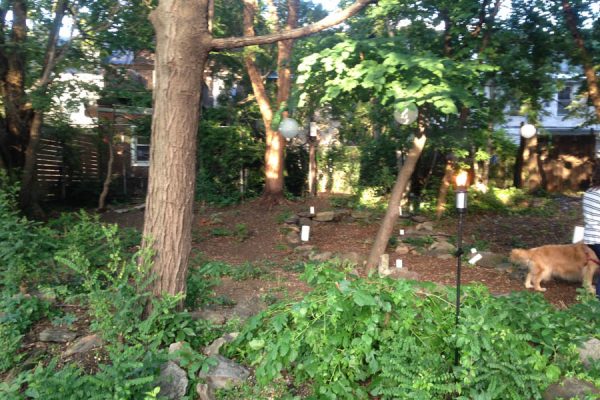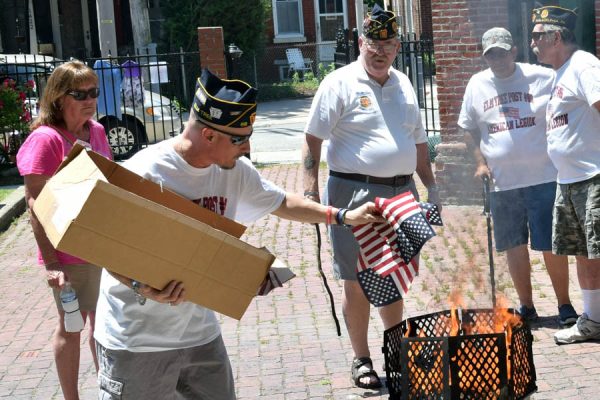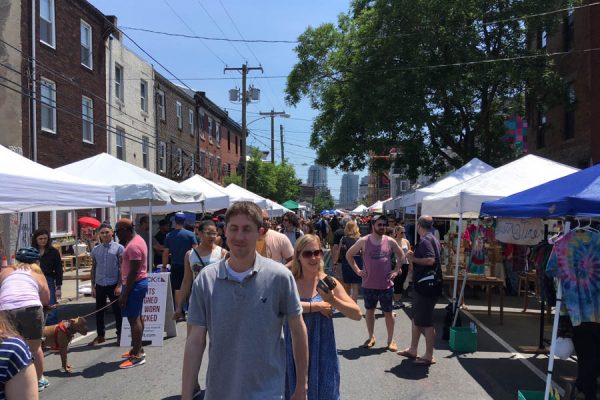Ghosts from Kensington’s Past: The Mutual Burial Grounds of Kensington Lie Dormant Beneath Fishtown
The ground beneath you holds more history than you know. Philadelphians that used to walk these neighborhoods more than 150 years ago are now buried under city streets. Most people would be surprised to learn that underneath the ground at Frankford Avenue & Blair and Berks Streets is an old cemetery that potentially holds 10,000+ graves.
From 1832-1868, a large burial ground was located underneath of the properties that sit on the 1800 block of Frankford and Blair. Remains of The Mutual Burial Grounds of Kensington rest under the Philadelphia Sculpture Gym, Tires & Auto Repair Shop, Shissler Recreation Center, and the baseball-field at Hewson & Blair.
Some remnants of the Mutual Burial Ground are protected from disturbance, sealed under structures that are non-invasive to the earth. However, structures on Frankford from 1834-46 can be purchased, demolished, and developed. Constructing building foundations and basements on this area could rip through thousands of bodies resting a few feet underground. Destroying burial grounds eliminates our potential to study the “burial customs, funeral practices, and…spiritual beliefs” of a population of local Philadelphians that have not been thoroughly studied previously.

Atlas of the City of Philadelphia, 18th, 19th, and 31st Wards, 1887 Created by: Geo. W. & Walter S. Bromley
“Philadelphia City Death Certificates, 1803-1915” show that most of the burials at Mutual Burial Ground of Kensington have been German-Americans. This demographic can be understood substantially more if specific archaeological surveys of the ground take place. However, when constructing buildings, “ground penetrating radar” is not set to the proper settings to find things like bones and pine coffins, but rather thousand-gallon gas tanks and larger obstructions. Luckily, almost the entire structure sitting on the cemetery was built on a concrete-slab, without basements (probably to avoid remains). Only trivial amounts of the earth were disturbed by these 1920s constructions, likely between 8” and 4’, which are too shallow to encounter human remains.
In addition to death certificates, proof of the Mutual Burial Ground’s existence is found in land deeds, numerous atlases and maps, church archives, the public ledger, and in the works of many historians.
In the 1730s, Kensington founder Anthony Palmer sold portions of his land called Hope Farm to many buyers, including Port Richmond founder William Ball. Ball rented his land to Revolutionary War hero John Hewson, who shared his property, at times, with his friends George and Martha Washington. Palmer sold the land that would become the Mutual Burial Ground to the Warders (Blair Street used to be named Warder Street) who owned it until 1832.
Church cemeteries filled quickly due to dense Philadelphia population in young-America. The Palmer family donated part of their land as a free cemetery that opened in 1765. Palmer Cemetery, while free, charged for burial costs, and did not guarantee you a plot near loved ones. Still, it was better for poor and working-class citizens, who could not afford church cemetery plots, starting at $100 plus fees (i.e. Christ Church).
Beginning in the 1820s, mutual burial grounds (not religiously-affiliated) arose throughout Philadelphia for poor citizens to affordably bury loved ones together. Family plots began at $10. Because the poor occupied these cemeteries, they were not exceptionally maintained and were often built on less-than-ideal land, which could lead to sinking gravestones (i.e. Franklin Square, but more on this later).
In 1831, two mutual burial grounds opened locally: Union Burial Ground of Northern Liberties and Kensington and Union Harmony Burial Ground. Archives in the Kensington Methodist Episcopal Church show that the Mutual Burial Ground of Kensington opened at Frankford & Berks (Blair Street did not cut through the block yet) by 1832.
A July 27, 1833 plot deed states Jacob Coleman and James McCormick were owners of the land, used “for burial purposes only” and that “no person of colour or those who have been publicly executed” could be buried there. This property had the dimensions of the Mutual Burial Ground, making them the owners of the cemetery. The earliest burial record for the site is dated 28 October 1832. They were buried by November 3rd.
The individual buried was 14-month-old Sarah Ann Cassady who died of marasmus, which is severe malnutrition causing the individual to appear emaciated. Sarah, who barely lived past her first birthday, is one of several thousands potentially buried underground at Frankford, Berks, and Blair.
Details of the 1833 plot deed described the men who split the property sale of the land: Jacob Coleman-dry goods merchant, James McCormick-shoe maker, Christopher Dillman-dentist, Nicholas Helverson-cabinet maker/well-known undertaker, and George W. Coleman-dry goods merchant. All of these men were from Northern Liberties.
 Several men co-purchasing a lower-class cemetery yielding little return-on-investment (if any) leads one to believes that this was an act of goodwill, for which Philadelphians were known. Ten months before Sarah Ann Cassady’s burial, Stephen Girard died, whose will delegated the largest-ever donation in American history (until Rockefeller 50+ years later) to build a school for orphans.
Several men co-purchasing a lower-class cemetery yielding little return-on-investment (if any) leads one to believes that this was an act of goodwill, for which Philadelphians were known. Ten months before Sarah Ann Cassady’s burial, Stephen Girard died, whose will delegated the largest-ever donation in American history (until Rockefeller 50+ years later) to build a school for orphans.
In the 1850s, William McNeely bought out the interest in the property from everyone on the 1833 deed, but it was still used for burials, with Nicholas Helverson as undertaker. Helverson also maintained the Franklin Cemetery; his sons followed in his footsteps.
The latest burial record discovered for the Mutual Burial Ground was for 8-month five-day-old Andrew Troop, who died of spinal cord inflammation on September 29, 1868. This means that the cemetery operated for at least 35 years, 10 months, 18 days. The cemetery likely stopped burials because it was full, since it still operated as a cemetery for almost 30 years after.
This space was consistently labeled “Cemetery,” “Burial Ground,” “Burying Ground,” and “Cem” on atlases and maps until 1892. 1895 atlases show the area empty and unlabeled. This could be because 27 years of nonuse cause gravestones to sink and grass to grow over them. Another possibility could be that the McNeely’s began covering or removing gravestones themselves to start selling off the land. Surveyors would consider the cemetery inactive and stop labeling it as such. The only record found of the cemetery closing is from May 11th, 1914. W.S. Helverson (Nicholas’s son) asked the city for permission to remove “200 bodies more or less” for relocation to Mt. Zion Cemetery for the cost of $25.
The land was joined together with other lots Charles McNeely (William’s son) owned, and converted into the Kensington Playground by 1922. The playground is now the location of the Shissler Recreation Center. By 1930, maps show garages built on Frankford, which is now home to the Philadelphia Sculpture Gym and the Auto Repair garage.

Andrew Troop, 8 months, 5 days old, died from inflammation of the spinal cord on 20 Sept. 1868, buried at the Mutual Burial Grounds of Kensington on 23 Sept. 1868. This represents the last burial record found thus far for this cemetery. Courtesy: Pennsylvania, Philadelphia City Death Certificates, 1807-1915.
The issue with the body removal proposal is the number of bodies “removed” from the location. Local Historian Kenneth Milano gathered a 38-week sample of burials that he cited in a Proposal for Historical Designation for this site, which the city is meeting about in two weeks. This sample purposefully excluded the years 1832-1849 in order to avoid abnormally high death tolls from multiple cholera and smallpox epidemics. Avoiding these years ensures that the burial rate is not skewed. The only burial from 1832 is for Sarah Ann Cassady, because it is the earliest-found record for the Mutual Burial Ground.
The sample’s burial rate is 6.3 per week (329 per year), which is 164.5 percent more bodies in just one year than McNeely’s 1914 cemetery removal for 36 years of burials. This rate equates to about 12,000 burials over the duration of its operation, without considering epidemic years. Realistically, this cemetery may be congested with 12,000+ bodies, but one can assume that at least several thousands of bodies still remain. Under the addresses 1834-46 Frankford Avenue is enough room for 500-1,000 graves.
In addition to enormous numbers of bodies being present (making it unlikely they were all removed), cemetery removal is notoriously incomplete and hastily done, especially for lower-class burial grounds. There are numerous examples of insufficient cemetery removal in Philadelphia.
The First African Baptist Church Cemetery closed in 1822. Hundreds of bodies were found in 1983-84 and again in 1990. The German Reformed Church Cemetery, closed in 1836, sank into the ground that became Franklin Square. Gravestones, coffins, and skulls were found in 1915, throughout the 1920s, and 1925, when buildings sewer lines, subway rails, and the Ben Franklin Bridge. Construction continued anyway. An archaeological survey was conducted during a 1976 sewer line project. Still, construction continued anyway. No other excavations took place.
3,000 bodies were found under a playground from the Mother Bethel Cemetery. Colonial graves were found at the Second Presbyterian Church Cemetery when the National Convention Center was built on top of it. Graves were found under a playground when building the William Dick Elementary School. Burials were found when constructing I-95. 300 bodies were found when building the Willard School, even though 8,000 bodies were “removed.”
There is definitive reason to believe that graves are still at the site of the Mutual Burial Ground of Kensington — of the thousands of bodies likely buried at the Mutual Burial Ground of Kensington, not a single record exists that these bodies were actually removed.








